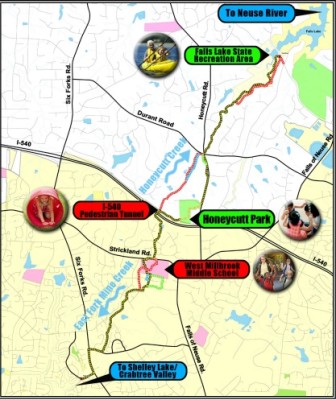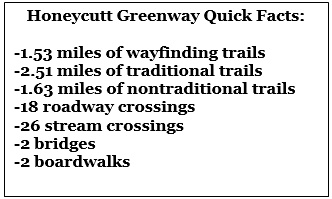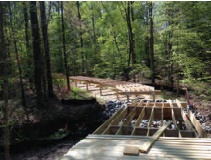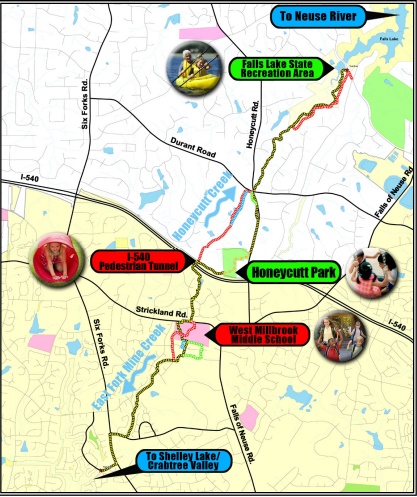Honeycutt Greenway Trail, a connector trail several years in the making that spans 5.6 miles in north Raleigh, will be opening to the public in early February.

City of Raleigh
A map of the Honeycutt Greenway Trail
Lisa Potts of the city’s Parks, Recreation and Cultural Resources department said the project will contain sidewalk connectors, a traditional paved greenway trail and an unpaved section that stretches into property owned by the U.S. Army Corps of Engineers.
Called a “spur trail” by Potts, Honeycutt Greenway Trail will connect users to trails that take them to Falls Lake to the north and Shelley Lake to the south. Its connectivity was said to be one of the primary benefits of the trail.
While the project was estimated in 2003 to cost $1.7 million, that number steadily rose due to inflation. By the time construction began in fall of 2013, the estimated cost for the project was $3 million.
The project has also undergone a high number of change orders. These amended the contract awarded to Rifenburg Construction for added work costs, have totaled $1 million. The money is made up from residual savings from other completed projects.
 Through the 2007 Parks Bond, the city gave a 5-7 year window to start the design phase for the Honeycutt Trail. Requests for Qualifications were sent out for design firms to submit proposals about their companies, including details about their employees, which range from designers, landscape architects, transportation engineers and others.
Through the 2007 Parks Bond, the city gave a 5-7 year window to start the design phase for the Honeycutt Trail. Requests for Qualifications were sent out for design firms to submit proposals about their companies, including details about their employees, which range from designers, landscape architects, transportation engineers and others.
The project required the change orders because of challenges faced when starting construction. After WSP Sells, the firm ultimately selected as lead designer on the project, had completed the layout of the trail, the project team discovered that the stream had changed dynamics and shifted to a new location.

Rifenburg Construction
A portion of the Honeycutt Greenway Trail during construction
A similar process played out when construction began. Bad soil had to be excavated and new soil, known as “fill material,” had to be trucked in. Easement map acquisitions, which allow the city to place trails on private property, took time and money as well.
“It is typical within projects to have change orders,” Potts said of the delays.
In the Capital Area Greenway Plan, greenway trails predominantly run along creeks. Because these areas are more prone to flooding than others and as such cannot be used for other structures, greenway trails have been used to preserve these areas. The trails also can connect users to destinations, such as shopping centers and schools.
The challenges facing the project, design, and construction team for Honeycutt Greenway Trail are very typical of constructing a new trail, Potts said. She added that she is very much looking forward to when the trail is opened because residents will have gotten what was promised and the trail will allow connections to different parts of the city.
“I’m going to be so excited!” she said.
The formal grand opening of Honeycutt Greenway Trail will take place in March.
